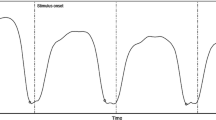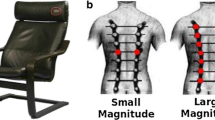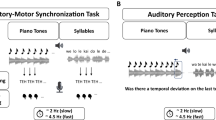Abstract
A local phase perturbation in an auditory sequence during synchronized finger tapping elicits an automatic phase correction response (PCR). The stimulus for the PCR is usually considered to be the most recent tap-tone asynchrony. In this study, participants tapped on target tones (“beats”) of isochronous tone sequences consisting of beats and subdivisions (1:n tapping). A phase perturbation was introduced either on a beat or on a subdivision. Both types of perturbation elicited a PCR, even though there was no asynchrony associated with a subdivision. Moreover, the PCR to a perturbed beat was smaller when an unperturbed subdivision followed than when there was no subdivision. The relative size of the PCRs to perturbed beats and subdivisions depended on tempo, on whether the subdivision was local or present throughout the sequence, and on whether or not participants engaged in mental subdivision, but not on whether or not taps were made on the subdivision level. The results show that phase correction in synchronization depends not merely on asynchronies but on perceptual monitoring of multiple temporal references within a metrical hierarchy.










Similar content being viewed by others
Notes
Large et al. (2002) call the events at the lowest metrical level (IOI = 400 ms) beats and thus do not talk about subdivisions. However, the perceived main beat (tactus) was probably either at the 1,600-ms level (because of the modular structure of the sequences) or at the 800-ms level (because at this rate the beat salience is maximal), so that the events at the lowest level functioned as subdivisions.
The experiment also contained sequences with much smaller, mostly subliminal EOSs (± 10 ms). The results, while generally consistent with those for the larger EOSs, were too variable to reach statistical significance and therefore are not reported.
All intervals are reported here as specified or recorded by the MAX software. It is known from acoustic measurements that the real-time temporal intervals generated or recorded by MAX in this configuration were shorter by about 2.4%.
Double standard errors are slightly smaller than two-tailed but slightly larger than one-tailed 95% confidence intervals. A one-tailed test against zero is justified here because mean PCRs are expected to be in the same direction as the EOS.
Relative times of occurrence are defined as the asynchronies of taps relative to an isochronous 560-ms time grid initiated by the first beat-level tone.
One type of sequence was missing in this design, namely sub EOS no beat with EOS = 0. During preparation of the materials it was overlooked that this sequence is not identical with the EOS = 0 versions of sub EOS + beat and sub + beat EOS.
Evidently, this last instruction was difficult to follow. Three participants tapped so lightly with their left (subdivision) hand that the taps sometimes were not registered. This happened particularly when the subdivision hand tapped in phase with the beat hand. As this was the least interesting part of the data (the two hands were expected to show similar PCRs when tapping in phase with each other), no steps were taken to correct this problem. For each participant, there were still sufficient trials with complete data to compute an (albeit less reliable) estimate of the PCR in the subdivision hand.
References
Aschersleben, G. (2002). Temporal control of movements in sensorimotor synchronization. Brain and Cognition, 48, 66–79.
Aschersleben, G., & Prinz, W. (1995). Synchronizing actions with events: The role of sensory information. Perception & Psychophysics, 57, 305–317.
Aschersleben, G., & Prinz, W. (1997). Delayed auditory feedback in synchronization. Journal of Motor Behavior, 29, 35–46.
Aschersleben, G., Stenneken, P., Cole, J., & Prinz, W. (2002). Timing mechanisms in sensorimotor synchronization: Intersensory integration of action effects. In W. Prinz & B. Hommel (Eds.), Attention and Performance XIX: Common mechanisms in perception and action (pp. 227–244). Oxford, U.K.: Oxford University Press.
Bolton, T. L. (1894). Rhythm. American Journal of Psychology, 6, 145–238.
Byblow, W. D., Chua, R., & Goodman, D. (1995). Asymmetries in coupling dynamics of perception and action. Journal of Motor Behavior, 27, 123–137.
Chen, Y., Ding, M., & Kelso, J. A. S. (1997). Long memory processes (1/f a type) in human coordination. Physical Review Letters, 79, 4501–4504.
Chen, Y., Ding, M., & Kelso, J. A. S. (2001). Origins of timing errors in human sensorimotor coordination. Journal of Motor Behavior, 33, 3–8.
Chen, Y., Repp, B. H., & Patel, A. D. (2002). Spectral decomposition of variability in synchronization and continuation tapping: Comparisons between auditory and visual pacing and feedback conditions. Human Movement Science, 21, 515–532.
Collyer, C. E., Boatright-Horowitz, S. S., & Hooper, S. (1997). A motor timing experiment implemented using a musical instrument digital interface (MIDI) approach. Behavior Research Methods, Instruments, & Computers, 29, 346–352.
Desain, P. (1992). A (de)composable theory of rhythm perception. Music Perception, 9, 439–454.
Drake, C., & Palmer, C. (1993). Accent structures in music performance. Music Perception, 10, 343–378.
Eck, D. (2002). Finding downbeats with a relaxation oscillator. Psychological Research, 66, 18–25.
Engström, D. A., Kelso, J. A. S., & Holroyd, T. (1996). Reaction–anticipation transitions in human perception–action patterns. Human Movement Science, 15, 809–832.
Fraisse, P., Oléron, G., & Paillard, J. (1958). Sur les repères sensoriels qui permettent de controler les mouvements d’accompagnement de stimuli périodiques. [On the sensory data that enable control of movements accompanying periodic stimuli.] L’Année Psychologique, 58, 322–338.
Franêk, M., Radil, T., & Indra, M. (1990). Subjective timing of rhythmical patterns during synchronization and reproduction of acoustic sequences. Studia Psychologica, 32, 203–209.
Franêk, M., Mates, J., Radil, T., Beck, K., & Pöppel, E. (1991). Sensorimotor synchronization: Motor responses to regular auditory patterns. Perception & Psychophysics, 49, 509–516.
Friberg, A., & Sundberg, J. (1995). Time discrimination in a monotonic, isochronous sequence. Journal of the Acoustical Society of America, 98, 2524–2531.
Hary, D., & Moore, G. P. (1985). Temporal tracking and synchronization strategies. Human Neurobiology, 4, 73–77.
Hary, D., & Moore, G. P. (1987). Synchronizing human movement with an external clock source. Biological Cybernetics, 56, 305–311.
Hibi, S. (1983). Rhythm perception in repetitive sound sequence. Journal of the Acoustical Society of Japan (E), 4, 83–95.
Keller, P. E., & Repp, B. H. (2004). When two limbs are weaker than one: Sensorimotor syncopation with alternating hands. Quarterly Journal of Experimental Psychology, 57A, 1085–1101.
Keller, P. E., & Repp, B. H. (2005). Staying offbeat: Sensorimotor syncopation with structured and unstructured auditory sequences. Psychological Research, 69, 292–309.
Kelso, J. A. S., DelColle, J. D., & Schöner, G. (1990). Action-perception as a pattern formation process. In M. Jeannerod (Ed.), Attention and performance XIII (pp. 139–169). Hillsdale, NJ: Erlbaum.
Large, E. W. (2000). On synchronizing movements to music. Human Movement Science, 19, 527–566.
Large, E. W. (2001). Periodicity, pattern formation, and metric structure. Journal of New Music Research, 30, 173–185.
Large, E. W., & Jones, M. R. (1999). The dynamics of attending: How we track time-varying events. Psychological Review, 106, 119–159.
Large, E. W., & Kolen, J. F. (1994). Resonance and the perception of musical meter. Connection Science, 6, 177–208.
Large, E. W., & Palmer, C. (2002). Perceiving temporal regularity in music. Cognitive Science, 26, 1–37.
Large, E. W., Fink, P., & Kelso, J. A. S. (2002). Tracking simple and complex sequences. Psychological Research, 66, 3–17.
Mates, J. (1994a). A model of synchronization of motor acts to a stimulus sequence. I. Timing and error corrections. Biological Cybernetics, 70, 463–473.
Mates, J. (1994b). A model of synchronization of motor acts to a stimulus sequence. II. Stability analysis, error estimation and simulations. Biological Cybernetics, 70, 475–484.
Mates, J., Radil, T., Müller, U., & Pöppel, E. (1994). Temporal integration in sensorimotor synchronization. Journal of Cognitive Neuroscience, 6, 332–340.
McAuley, J. D., & Jones, M. R. (2003). Modeling effects of rhythmic context on perceived duration: A comparison of interval and entrainment approaches to short-interval timing. Journal of Experimental Psychology: Human Perception and Performance, 29, 1102–1125.
Nagasaki, H. (1987a). Correlations of stress and timing in periodic tapping. Human Movement Science, 6, 161–180.
Nagasaki, H. (1987b). Frequency dependence of rhythm in periodic tapping. Human Movement Science, 6, 247–256.
van Noorden, L., & Moelants, D. (1999). Resonance in the perception of musical pulse. Journal of New Music Research, 28, 43–66.
Parncutt, R. (1994). A perceptual model of pulse salience and metrical accent in musical rhythms. Music Perception, 11, 409–464.
Penel, A., & Drake, C. (1998). Sources of timing variations in music performance: A psychological segmentation model. Psychological Research, 61, 12–32.
Penel, A., & Drake, C. (2004). Timing variations in music performance: Musical communication, perceptual compensation, and/or motor control? Perception & Psychophysics, 66, 545–562.
Peper, C. E., & Beek, P. J. (1998). Distinguishing between the effects of frequency and amplitude on interlimb coupling in tapping a 2:3 polyrhythm. Experimental Brain Research, 118, 78–92.
Peper, C. E., Beek, P. J., & van Wieringen, P. C. W. (1995). Coupling strength in tapping a 2:3 polyrhythm. Human Movement Science, 14, 217–245.
Peters, M. (1989). The relationship between variability of intertap intervals and interval duration. Psychological Research, 51, 38–42.
Pressing, J. (1998). Error correction processes in temporal pattern production. Journal of Mathematical Psychology, 42, 63–101.
Pressing, J. (1999). The referential dynamics of cognition and action. Psychological Review, 106, 714–747.
Pressing, J., & Jolley-Rogers, G. (1997). Spectral properties of human cognition and skill. Biological Cybernetics, 76, 339–347.
Repp, B. H. (1997). Acoustics, perception, and production of legato articulation on a computer-controlled grand piano. Journal of the Acoustical Society of America, 102, 1878–1890.
Repp, B. H. (1999a). Detecting deviations from metronomic timing in music: Effects of perceptual structure on the mental timekeeper. Perception & Psychophysics, 61, 529–548.
Repp, B. H. (1999b). Control of expressive and metronomic timing in pianists. Journal of Motor Behavior, 31, 145–164.
Repp, B. H. (1999c). Relationships between performance timing, perception of timing perturbations, and perceptual-motor synchronization in two Chopin preludes. Australian Journal of Psychology, 51, 188–203.
Repp, B. H. (2000). Compensation for subliminal timing perturbations in perceptual-motor synchronization. Psychological Research, 63, 106–128.
Repp, B. H. (2001a). Phase correction, phase resetting, and phase shifts after subliminal timing perturbations in sensorimotor synchronization. Journal of Experimental Psychology: Human Perception and Performance, 27, 600–621.
Repp, B. H. (2001b). Processes underlying adaptation to tempo changes in sensorimotor synchronization. Human Movement Science, 20, 277–312.
Repp, B. H. (2002a). Automaticity and voluntary control of phase correction following event onset shifts in sensorimotor synchronization. Journal of Experimental Psychology: Human Perception and Performance, 28, 410–430.
Repp, B. H. (2002b). Effects of metrical structure on phase resetting in sensorimotor synchronization. In C. Stevens, D. Burnham, G. McPherson, E. Schubert, & J. Renwick (Eds.), Proceedings of the Seventh International Conference on Music Perception and Cognition (pp. 572–574). Sydney: Causal Productions (CD-ROM).
Repp, B. H. (2002c). Phase correction following a perturbation in sensorimotor synchronization depends on sensory information. Journal of Motor Behavior, 34, 291–298.
Repp, B. H. (2002d). Phase correction in sensorimotor synchronization: Nonlinearities in voluntary and involuntary responses to perturbations. Human Movement Science, 21, 1–37.
Repp, B. H. (2003). Rate limits in sensorimotor synchronization with auditory and visual sequences: The synchronization threshold and the benefits and costs of interval subdivision. Journal of Motor Behavior, 35, 355–370.
Repp, B. H. (2005). Sensorimotor synchronization: A review of the tapping literature. Psychonomic Bulletin & Review, 12, 969–992.
Repp, B. H., & Keller, P. E. (2004). Adaptation to tempo changes in sensorimotor synchronization: Effects of intention, attention, and awareness. Quarterly Journal of Experimental Psychology, 57A, 10.
Schulze, H.-H. (1992). The error correction model for the tracking of a random metronome: Statistical properties and an empirical test. In F. Macar, V. Pouthas, & W. J. Friedman (Eds.), Time, action, and cognition (pp. 275–286). Dordrecht: Kluwer.
Schulze, H.-H., Cordes, A., & Vorberg, D. (2005). Keeping synchrony while tempo changes: Accelerando and ritardando. Music Perception, 22, 461–477.
Semjen, A., Schulze, H.-H., & Vorberg, D. (1992). Temporal control in the coordination between repetitive tapping and periodic external stimuli. In C. Auxiette, C. Drake, & C. Gérard (Eds.), Proceedings of the Fourth Rhythm Workshop: Rhythm Perception and Production (pp. 73–78). Bourges, France: Imprimérie Municipale.
Semjen, A., Schulze, H.-H., & Vorberg, D. (2000). Timing precision in continuation and synchronization tapping. Psychological Research, 63, 137–147.
Thaut, M. H., Miller, R. A., & Schauer, L. M. (1998). Multiple synchronization strategies in rhythmic sensorimotor tasks: phase vs period correction. Biological Cybernetics, 79, 241–250.
Thaut, M. H., Tian, B., & Azimi-Sadjadi, M. R. (1998). Rhythmic finger tapping to cosine-wave modulated metronome sequences: Evidence of subliminal entrainment. Human Movement Science, 17, 839–863.
Todd. N. P. McA., Lee, C. S., & O’Boyle, D. J. (2002). A sensorimotor theory of temporal tracking and beat induction. Psychological Research, 66, 26–39.
Vorberg, D., & Hambuch, R. (1978). On the temporal control of rhythmic performance. In J, Requin (Ed.), Attention and Performance VII (pp. 535–556). Hillsdale: Erlbaum.
Vorberg, D., & Hambuch, R. (1984). Timing of two-handed rhythmic performance. In J. Gibbon & L. Allan (Eds.), Timing and time perception (pp. 390–406). New York: New York Academy of Sciences (Annals, Vol. 423).
Vorberg, D., & Schulze, H.-H. (2002). A two-level timing model for synchronization. Journal of Mathematical Psychology, 46, 56–87.
Vorberg, D., & Wing, A. (1996). Modeling variability and dependence in timing. In H. Heuer & S. W. Keele (Eds.), Handbook of perception and action, vol. 2 (pp. 181–262). London: Academic.
Vos, P. G., & Helsper, E. L. (1992). Tracking simple rhythms: In-phase versus anti-phase performance. In F. Macar, V. Pouthas, & W. J. Friedman (Eds.), Time, action, and cognition: Towards bridging the gap (pp. 287–299). Dordrecht: Kluwer.
Wimmers, R. H., Beek, P. J., & van Wieringen, P. C. W. (1992). Phase transitions in rhythmic tracking movements: A case of unilateral coupling. Human Movement Science, 11, 217–226.
Wohlschläger, A., & Koch, R. (2000). Synchronization error: an error in time perception. In P. Desain & L. Windsor (Eds.), Rhythm perception and production (pp. 115–128). Lisse, The Netherlands: Swets & Zeitlinger.
Acknowledgments
This research was supported by NIH grant MH-51230. Experiments 3, 4, 5 and 6 and preparation of the manuscript were also partially supported by NIH grants DC-03663 (Elliot Saltzman, P.I.) and HD-01994 (Carol Fowler, P.I.). Thanks are due to these colleagues for their generous support, to Yoko Hoshi, Helen Sayward, and Susan Holleran for help with data analysis, and to Amandine Penel, Susan Holleran, and Peter Keller for helpful comments on earlier versions of the manuscript. Experiment 1 was reported previously in Repp (2002b).
Author information
Authors and Affiliations
Corresponding author
Rights and permissions
About this article
Cite this article
Repp, B.H. Multiple temporal references in sensorimotor synchronization with metrical auditory sequences. Psychological Research 72, 79–98 (2008). https://doi.org/10.1007/s00426-006-0067-1
Received:
Accepted:
Published:
Issue Date:
DOI: https://doi.org/10.1007/s00426-006-0067-1




